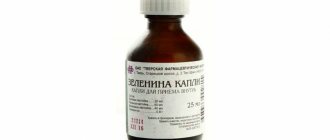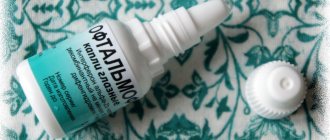Diseases of the visual organs reduce the comfort of life. The causes of ailments can be different, ranging from mechanical damage to their infectious nature. To avoid mistakes with treatment, you need to consult a specialist. The doctor will diagnose and prescribe therapy and medications that can be bought at an online pharmacy in Moscow. As a rule, the complex includes Levomycetin drops for the eyes.
Instructions for use and dosage regimen
If the doctor has not prescribed a special regimen, the drops are used 3-4 times a day, placing 1-2 drops into the conjunctival sac of each eye. The total treatment period cannot last more than 5 days, even if the patient’s condition has improved significantly and there is a desire to continue therapy.
The drug is available in the form of a liquid poured into a bottle with a dropper cap. Before use, remove the aluminum cap from the container, remove the rubber stopper and place the dropper cap on the bottle. Remove the protective cap from the lid, turn the bottle over, shake and apply drops to your eyes. After use, return the bottle to a vertical position and put the protective cap on the dropper.
In some cases, adjustment of the dose and frequency of use is required, so before using Levomycetin drops for the eyes, you must consult a specialist!
Possible side effects of the drug
The drug has a considerable list of side effects:
- Burning, itching of the organs of vision. The sensations are short-term, treatment is not stopped.
- Dermatitis, urticaria, fever are possible with low immunity. If hypersensitivity is accompanied by anaphylaxis or angioedema, inform your doctor immediately. Therapy with drops is stopped.
Negative responses from the hematopoietic system, blood supply, and lymph flow are extremely rarely observed. They manifest themselves as aplastic anemia or bone marrow hypoplasia.
Levomycetin 0.25% bottle 10ml eye drops
A country
Russia
The country of production may vary depending on the batch of goods. Please check with the operator for detailed information when confirming your order.
Compound
10 ml - polymer dropper bottle. Eye drops 0.25%. Per 1 ml chloramphenicol 2.5 mg.
pharmachologic effect
Broad-spectrum antibiotic. The mechanism of antimicrobial action is associated with a violation of the synthesis of microbial proteins. Has a bacteriostatic effect. Active against gram-positive bacteria: Staphylococcus spp., Streptococcus spp.; gram-negative bacteria: Neisseria gonorrhoeae, Neisseria meningitidis, Escherichia coli, Haemophilus influenzae, Salmonella spp., Shigella spp., Klebsiella spp., Serratia spp., Yersinia spp., Proteus spp., Rickettsia spp.; also active against Spirochaetaceae and some large viruses. Chloramphenicol is active against strains resistant to penicillin, streptomycin, and sulfonamides. Resistance of microorganisms to chloramphenicol develops relatively slowly.
Indications for use
For oral administration: infectious and inflammatory diseases caused by microorganisms sensitive to chloramphenicol, including: typhoid fever, paratyphoid fever, dysentery, brucellosis, tularemia, whooping cough, typhus and other rickettsioses; trachoma, pneumonia, meningitis, sepsis, osteomyelitis. For external use: purulent skin lesions, boils, long-term non-healing trophic ulcers, second and third degree burns, cracked nipples in nursing women. For local use in ophthalmology: inflammatory eye diseases.
Mode of application
Individual. When taken orally, the dose for adults is 500 mg 3-4 times a day. Single doses for children under 3 years of age - 15 mg/kg, 3-8 years - 150-200 mg; over 8 years old - 200-400 mg; frequency of use - 3-4 times/day. The course of treatment is 7-10 days. For external use, apply to gauze pads or directly to the affected area. Apply a regular bandage on top, possibly with parchment or compress paper. Dressings are performed depending on the indications after 1-3 days, sometimes after 4-5 days. Used locally in ophthalmology as part of combination drugs in accordance with indications.
Interaction
With the simultaneous use of chloramphenicol with oral hypoglycemic drugs, an increase in the hypoglycemic effect is observed due to the suppression of the metabolism of these drugs in the liver and an increase in their concentration in the blood plasma. When used simultaneously with drugs that inhibit bone marrow hematopoiesis, there is an increased inhibitory effect on the bone marrow. When used simultaneously with erythromycin, clindamycin, lincomycin, a mutual weakening of the effect is observed due to the fact that chloramphenicol can displace these drugs from the bound state or prevent their binding to the 50S subunit of bacterial ribosomes. When used simultaneously with penicillins, chloramphenicol counteracts the bactericidal effect of penicillin. Chloramphenicol suppresses the cytochrome P450 enzyme system, therefore, when used simultaneously with phenobarbital, phenytoin, warfarin, a weakening of the metabolism of these drugs, a slower elimination and an increase in their concentration in the blood plasma are observed.
Side effect
From the hematopoietic system: thrombocytopenia, leukopenia, agranulocytosis, aplastic anemia. From the digestive system: nausea, vomiting, diarrhea, flatulence. From the central nervous system and peripheral nervous system: peripheral neuritis, optic neuritis, headache, depression, confusion, delirium, visual and auditory hallucinations. Allergic reactions: skin rash, urticaria, angioedema. Local reactions: irritant (for external or local use).
Contraindications
Blood diseases, severe liver dysfunction, deficiency of the enzyme glucose-6-phosphate dehydrogenase, skin diseases (psoriasis, eczema, fungal diseases); pregnancy, lactation, children up to 4 weeks of age (newborns), hypersensitivity to chloramphenicol, thiamphenicol, azidamphenicol.
special instructions
Chloramphenicol is not used in newborns, because the development of “gray syndrome” is possible (flatulence, nausea, hypothermia, gray-blue skin color, progressive cyanosis, dyspnea, cardiovascular failure). Use with caution in patients who have previously received treatment with cytotoxic drugs or radiation therapy. With simultaneous intake of alcohol, a disulfiram-like reaction may develop (skin hyperemia, tachycardia, nausea, vomiting, reflex cough, convulsions). During treatment, systematic monitoring of peripheral blood patterns is necessary.
Precautions when taking Levomycetin drops for eyes
Not all patients are aware of sensitivity to the components of the drug. Experts recommend using the product with extreme caution in the following cases:
- If hypersensitivity to components is detected.
- During the period of GVS (refusal of breastfeeding or selection of other medications is required).
- Age up to 2 years.
- Age from 65 years.
- Pre-treatment with radiation therapy or the use of cytostatic drugs.
High content of the main product may cause toxic effects if drops are swallowed. In this case, the patient develops pain, swelling, and increased lacrimation. It is recommended to rinse your eyes thoroughly with clean water for at least 15 minutes, then either continue treatment or call an ambulance.
When to see a doctor
The need to consult an ophthalmologist arises when severe pain, blurred vision, or fear of light occurs. In rare cases, damage to the skin occurs, a sensation of a foreign body appears in the eye - these are all alarming signs that require consultation with a specialist.
Levomycetin eye drops 2.5 mg/ml 5 ml No. 1
Name
Levomycetin k-li gl 2.5 mgml fl 5 ml in pack No. 1 BMP
Description
Transparent colorless or slightly colored solution.
Main active ingredient
Chloramphenicol
Release form
Eye patches
Dosage
2.5 mg/ml
pharmachologic effect
A broad-spectrum bacteriostatic antibiotic that disrupts the process of protein synthesis in the microbial cell. Effective against strains of bacteria resistant to penicillin, tetracyclines, and sulfonamides. Active against: Escherichia coli, Haemophilus influenzae, Klebsiella pneumoniae, some species of Enterobacter and Neisseria, Staphylococcus aureus, Streptococcus spp. (including Streptococcus pneumoniae, Streptococcus hemolyticus), Moraxella lacunata, rickettsia and mycoplasma. Ineffective against Pseudomonas aeruginosa, Serratia marcescens.
Indications for use
Bacterial eye infections caused by sensitive microflora: conjunctivitis, keratitis, blepharitis, blepharoconjunctivitis, keratoconjunctivitis.
Directions for use and doses
The drug is used locally in the form of instillations into the conjunctival sac, 1-2 drops 3-4 times a day. Treatment should continue for no more than 5 days, even if the condition improves. Elderly patients (over 65 years old). No dose adjustment is required. Recommendations for using bottles with dropper caps: before using the drug, remove the aluminum cap from the bottle, remove the rubber stopper and close the bottle with the dropper cap, previously removed from the packaging. Then remove the cap from the dropper cap, turn the bottle over, and add the required number of drops of the drug. After use, return the bottle to a vertical position and place the cap on the dropper cap.
Use during pregnancy and lactation
Animal studies have shown that chloramphenicol has embryotoxic and teratogenic effects. Chloramphenicol passes through the placenta. The safety of using eye drops during pregnancy has not been established, so use is contraindicated. Chloramphenicol is excreted in breast milk. During the use of eye drops, systemic absorption of the drug cannot be excluded. Therefore, due to the risk of serious adverse reactions in children, use during breastfeeding is contraindicated.
Impact on the ability to drive vehicles and potentially dangerous mechanisms
Eye drops may cause temporary blurred vision. Patients should not drive a car or operate machinery until vision is restored.
Precautionary measures
Long-term use of Levomycetin eye drops should be avoided, since there is a possibility of developing hypersensitivity and the emergence of resistant microorganisms. The drug contains boric acid, which can cause toxic reactions. Chloramphenicol is susceptible to systemic absorption from the eye, and toxicity has been reported with chronic exposure. Bone marrow hypoplasia, including aplastic anemia and death, has been reported following topical administration of chloramphenicol. Although the hazard is rare, the balance between expected risk and benefit should be assessed before using the drug. When using the drug on a long-term or intermittent basis, it is advisable to perform routine blood tests before starting therapy and at appropriate intervals thereafter to detect any changes in hematopoiesis. Prescribe with caution to patients who have previously received treatment with cytotoxic drugs or radiation therapy. Patients should consult a doctor if any of the following conditions occur: blurred vision; severe pain in the eyes; photophobia; the appearance of rashes on the face and head; the eye looks cloudy; the pupil looks unusual; there was a feeling of a foreign body in the eye. Patients must inform the doctor about: – previous conjunctivitis; – glaucoma; – “dry eye” syndrome; – eye surgery or laser therapy within the last 6 months; – eye injury; – current use of other eye drops or eye ointment; – wearing contact lenses. Contact lenses should not be worn during the course of treatment. Soft contact lenses should not be worn for 24 hours after completion of treatment.
Interaction with other drugs
Simultaneous use of chloramphenicol with drugs that inhibit hematopoiesis (sulfonamides, cytostatics), affecting metabolism in the liver; with radiation therapy increases the risk of side effects. Therefore, such combinations should be avoided. When used simultaneously with erythromycin, clindamycin, lincomycin, a mutual weakening of the effect is observed due to the fact that chloramphenicol can prevent their binding to the 50S subunit of bacterial ribosomes. Levomycetin reduces the antibacterial effect of penicillins and cephalosporins. When combined with chloramphenicol and oral hypoglycemic drugs, an increase in their effect is observed due to the suppression of metabolism in the liver and an increase in their concentration in plasma. Chloramphenicol suppresses the cytochrome P450 enzyme system, therefore, when used simultaneously with phenobarbital, phenytoin, and indirect anticoagulants, there is a weakening of the metabolism of these drugs, a slower elimination and an increase in their concentration in plasma. Storage conditions
Contraindications
Hypersensitivity to chloramphenicol (as well as thiamphenicol, azidamphenicol), inhibition of bone marrow hematopoiesis, acute intermittent porphyria, glucose-6-phosphate dehydrogenase deficiency, liver and/or renal failure, myelosuppression due to a history of chloramphenicol use, personal or family history of myelosuppression, diseases skin (psoriasis, eczema, fungal infections), pregnancy, lactation (no breastfeeding is required), children under 2 years of age. It should be used with caution in childhood, in patients who have previously received treatment with cytotoxic drugs or radiation therapy.
Compound
For one bottle (5 ml): active substance: chloramphenicol – 12.5 mg; excipients: boric acid, water for injection.
Overdose
Accidental ingestion of eye drops is unlikely to cause systemic toxicity due to the low content of chloramphenicol. If pain, swelling, watery eyes or photophobia develop, flush the affected eye with water for at least 15 minutes. If the above symptoms persist, you should consult a doctor.
Side effect
From the organ of vision: short-term irritation, burning, itching, conjunctival hyperemia. From the immune system: hypersensitivity reactions, angioedema, anaphylaxis, urticaria, fever, dermatitis. From the blood and lymphatic system: there is some information about the development of bone marrow hypoplasia and aplastic anemia after the use of ophthalmic forms of chloramphenicol. If any adverse reactions occur, including those not listed in these instructions, you should consult a doctor.
Storage conditions
In a place protected from light at a temperature not exceeding 25 °C. Store the opened bottle in a place protected from light at a temperature of 15 °C to 25 °C for 4 weeks. Keep out of the reach of children.







